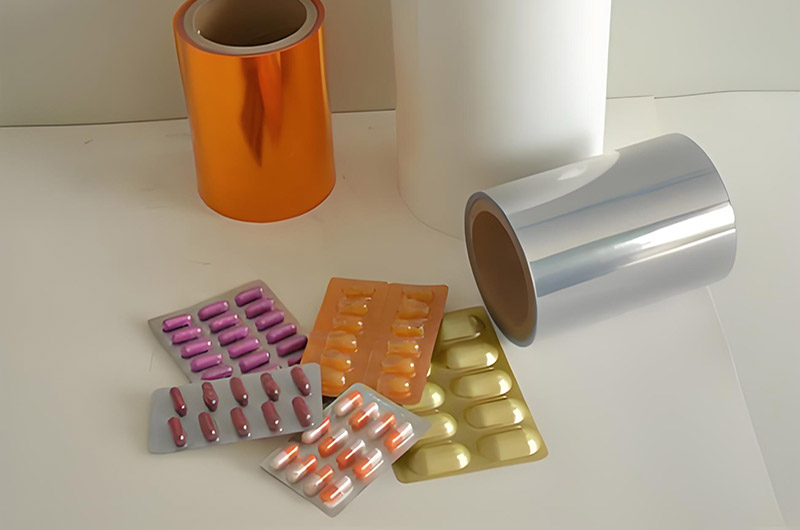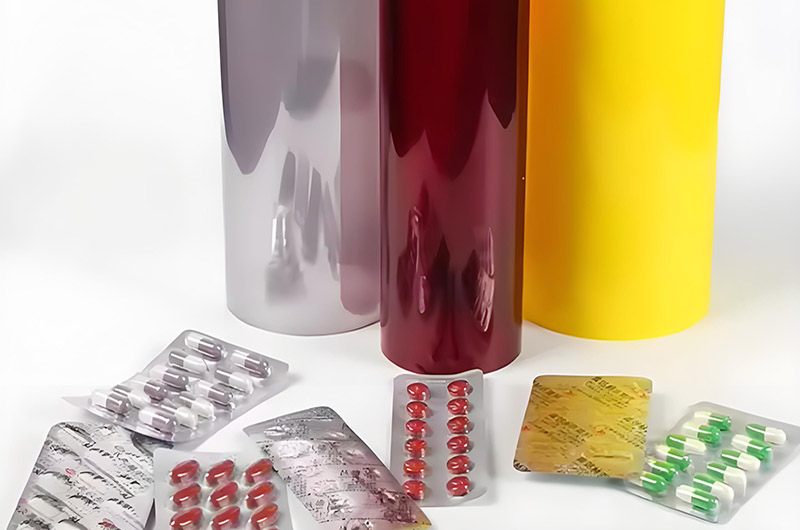PVC/PVDC Aluminium Blister Packaging
PVC/PVDC aluminum blister is a high-performance composite structure widely used in pharmaceutical packaging. Its core is composed of polyvinyl chloride (PVC) and polyvinylidene chloride (PVDC) composite rigid film, with an aluminum foil sealing layer on the surface.
PVC/PVDC aluminum blister packaging is a protective solution extensively used in the pharmaceutical industry for solid oral medications such as tablets and capsules. This packaging combines multiple materials to provide optimal environmental protection, ensuring drug efficacy and shelf life.
PVC/PVDC aluminum blister packaging provides a reliable and effective method to protect medications, ensuring their safety, effectiveness, and durability.

PVC/PVDC Aluminium Blister Composition and Structure
A typical PVC/PVDC aluminum blister package contains the following layers:
- PVC (Polyvinyl Chloride): Serves as the base material, providing structural integrity and formability. The typical thickness range of PVC is 200–300 microns (0.20–0.30 mm), with 250 microns being the most commonly used thickness for pharmaceutical applications.
- PVDC (Polyvinylidene Chloride): Coated on the PVC layer to enhance barrier properties against moisture, oxygen, and other gases. PVDC coating weights vary (e.g., 40/60/90/120 gsm), with higher weights offering superior protection against moisture, oxygen, and odors.
- Aluminum Foil: Used as the lidding material, providing additional protection against light, moisture, and contamination. It is sealed onto the PVC/PVDC film to form a sealed compartment. The aluminum foil acts as a secondary barrier and allows tablets or capsules to be easily pushed through.
This multilayer structure ensures that the medication is well protected from external factors that may affect its quality.
PVC/PVDC Aluminium Blister Material Characteristics and Layer Composition
| Layer | Material Name | Main Function/Property | Technical Description and Advantages |
| Outer Layer | PVC Rigid Film | Structural Support | Excellent thermoforming processability, suitable for deep blister forming |
| Thermoformability | Good mechanical strength, supports the entire blister structure | ||
| Low Cost | Good transparency, convenient for displaying medicines | ||
| Weak barrier property, requires composite enhancement | |||
| Middle Layer | PVDC Coating | High Barrier Layer | Excellent resistance to water vapor and oxygen |
| Moisture and Oxidation Resistance | Oxygen barrier rate is over 100 times higher than that of PVC | ||
| Suitable for packaging moisture-sensitive medicines | |||
| Good stability, prolongs drug shelf life | |||
| Inner Layer | Aluminum Foil | Light Protection | Typical thickness is 20–40 μm |
| Sealing Protection | High density, effectively blocks moisture, oxygen, and light | ||
| Barrier to Gases and Moisture | Excellent heat sealing performance, ensures sealed packaging, prevents drug oxidation and degradation |
- Composite Method: Typically employs coating, lamination, and other processes to tightly bond the three-layer materials, forming a complete composite film.
- Heat Sealing Technology: Forms good heat sealing properties with PVC, creating a blister-sealed chamber in combination with aluminum foil.
- Application Fields: Widely used for packaging moisture- or oxygen-sensitive drugs such as antibiotics, vitamins, anti-allergy medicines, and contraceptives.
PVC/PVDC Aluminium Blister Specifications
| Item | Specifications and Descriptions |
| Thickness | PVC Thickness: 0.20–0.45 mm (typically 250µ or 300µ) |
| Special Applications: Customizable thickness up to 1000 µm | |
| Moisture Barrier (WVTR) | The thicker the PVDC coating, the lower the water vapor transmission rate |
| 40 gsm PVDC: ≤ 0.8 g/m²/24h | |
| 120 gsm PVDC: ≤ 0.4 g/m²/24h | |
| Oxygen Barrier (OTR) | Oxygen transmission rate of high-coated PVDC film can be as low as 0.1 cc/m²/day |
| Color and Customization | Available in transparent, white, silver, or opaque colors (e.g., yellow, orange, etc.) |
| UV filters or pigments can be added upon request |
PVC/PVDC Aluminium Blister Features
- Enhanced Barrier Protection: PVDC coating significantly improves moisture and gas resistance, making it suitable for sensitive drugs requiring strict protection.
- Transparency: The transparent nature of PVC allows for visual inspection of the drug, helping to identify and reduce the risk of errors.
- Mechanical Strength: PVC provides the necessary rigidity and strength to withstand the pressure during handling and transportation without compromising the integrity of the blister.
- Chemical Resistance: The combination of PVC and PVDC can withstand various chemicals, ensuring the packaging does not adversely react with the medication.
- Cost-Effectiveness: Compared with other high-barrier materials, PVC/PVDC strikes a balance between performance and cost, making it a preferred choice for many pharmaceutical applications.

PVC/PVDC Aluminium Blister Applications
PVC/PVDC aluminum blister packaging is mainly used for:
- Solid oral dosage forms: such as tablets and capsules, especially suitable for formulations sensitive to moisture and oxygen.
- Unit dose packaging: helps in accurate dosing and improves patient compliance.
- Tablets, capsules, and hygroscopic or photosensitive medications.
- Suppositories and liquid medications (via PVC/PE composite materials).
- Food-grade packaging produced according to pharmaceutical-grade standards (e.g., candies, chewing gum).
- Shelf-life extension products: medications that need to remain stable under various environmental conditions for a long period.
PVC/PVDC blister packaging offers excellent protection performance, but due to the material combination, recycling may pose challenges.
PVC/PVDC Aluminium Blister Advantages
- Enhanced Protection: Combines the rigidity of PVC with the high barrier properties of PVDC to effectively block moisture, oxygen, and contaminants.
- Cost Effectiveness: Lower production costs compared to alternatives such as PCTFE or COC laminated sheets.
- Thermoforming Efficiency: Compatible with rotary and flat blister machines for high-speed production.
PVC/PVDC Aluminium Blister Production Process Flow
| Process Step | Description |
| Rigid Film Pre-treatment | PVC/PVDC rigid film is softened using a heating device. |
| Heating temperature is controlled at 120–150℃ to improve plasticity and facilitate forming. | |
| Blister Forming | Uses vacuum forming or pressure forming processes. |
| Forming blister cavities on the mold. | |
| Forming depth: Standard for pharmaceutical packaging is 3–10mm; special applications (e.g. medical devices) up to 60mm. | |
| Drug Filling and Lamination | After cooling the blister, drugs are filled. |
| Aluminum foil is applied and sealed using a heat sealing device. | |
| Sealing temperature is 160℃ ± 5℃; pressure sealing ensures sealing strength ≥ 1.5N/15mm. | |
| Post-treatment | Includes printing, punching, and final product inspection. |
| Inspection items include: heat seal strength, barrier performance tests, etc., to ensure product quality. |
PVC/PVDC Aluminium Blister Key Performance Indicators
| Performance Category | Indicator Item | Specific Requirements and Description |
| Mechanical Properties | Tensile Strength | Average value (longitudinal/transverse) ≥ 40 MPa |
| Impact Resistance | Passed drop ball impact test (steel ball free fall), number of damaged samples in both directions ≤ 2 | |
| Thermal Properties | Heat Seal Strength | Ensures sealing integrity; heat seal test values must meet requirements of standards such as the Chinese Pharmacopoeia. |
| Thermal Shrinkage Rate | Dimensional changes after heating must be within ±6%. | |
| Barrier Properties | Oxygen Transmission Rate (OTR) | PVDC composite layer can reduce oxygen transmission rate to ≤ 5 cm³/(m²·24h·0.1MPa) |
| Water Vapor Transmission Rate (WVTR) | Aluminum foil composite structure achieves WVTR ≤ 0.1 g/(m²·24h), providing excellent moisture resistance. |

